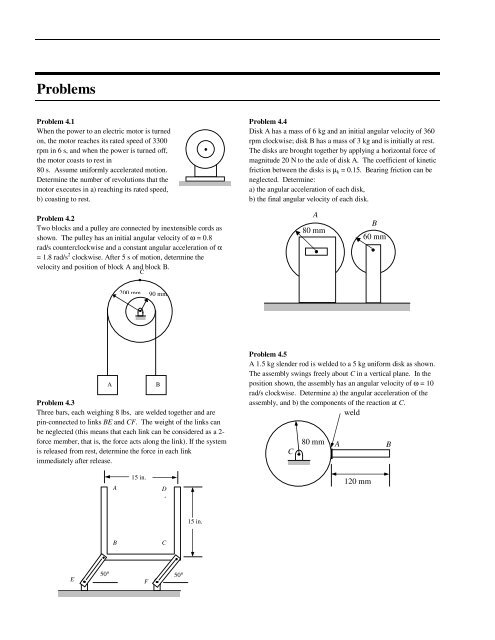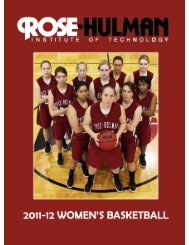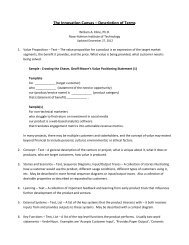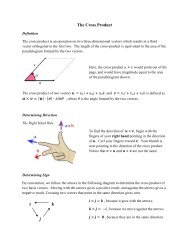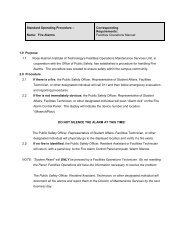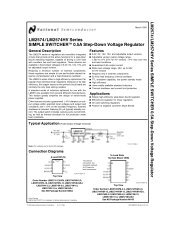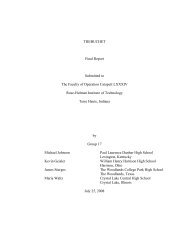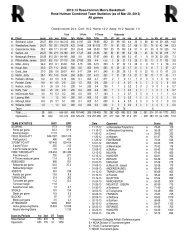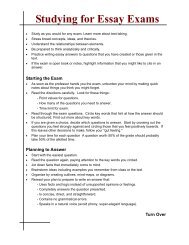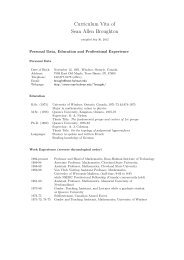Problems - Rose-Hulman
Problems - Rose-Hulman
Problems - Rose-Hulman
Create successful ePaper yourself
Turn your PDF publications into a flip-book with our unique Google optimized e-Paper software.
<strong>Problems</strong><br />
Problem 4.1<br />
When the power to an electric motor is turned<br />
on, the motor reaches its rated speed of 3300<br />
rpm in 6 s, and when the power is turned off,<br />
the motor coasts to rest in<br />
80 s. Assume uniformly accelerated motion.<br />
Determine the number of revolutions that the<br />
motor executes in a) reaching its rated speed,<br />
b) coasting to rest.<br />
Problem 4.4<br />
Disk A has a mass of 6 kg and an initial angular velocity of 360<br />
rpm clockwise; disk B has a mass of 3 kg and is initially at rest.<br />
The disks are brought together by applying a horizontal force of<br />
magnitude 20 N to the axle of disk A. The coefficient of kinetic<br />
friction between the disks is µ k = 0.15. Bearing friction can be<br />
neglected. Determine:<br />
a) the angular acceleration of each disk,<br />
b) the final angular velocity of each disk.<br />
Problem 4.2<br />
Two blocks and a pulley are connected by inextensible cords as<br />
shown. The pulley has an initial angular velocity of ω = 0.8<br />
rad/s counterclockwise and a constant angular acceleration of α<br />
= 1.8 rad/s 2 clockwise. After 5 s of motion, determine the<br />
velocity and position of block A and block B.<br />
C<br />
A<br />
80 mm<br />
B<br />
60 mm<br />
200 mm<br />
90 mm<br />
A<br />
Problem 4.3<br />
Three bars, each weighing 8 lbs, are welded together and are<br />
pin-connected to links BE and CF. The weight of the links can<br />
be neglected (this means that each link can be considered as a 2-<br />
force member, that is, the force acts along the link). If the system<br />
is released from rest, determine the force in each link<br />
immediately after release.<br />
B<br />
Problem 4.5<br />
A 1.5 kg slender rod is welded to a 5 kg uniform disk as shown.<br />
The assembly swings freely about C in a vertical plane. In the<br />
position shown, the assembly has an angular velocity of ω = 10<br />
rad/s clockwise. Determine a) the angular acceleration of the<br />
assembly, and b) the components of the reaction at C.<br />
weld<br />
C<br />
80 mm<br />
A<br />
B<br />
A<br />
15 in.<br />
D<br />
120 mm<br />
A<br />
15 in.<br />
B<br />
C<br />
E<br />
50° 50°<br />
F
Problem 4.6<br />
A slender 4 kg rod can rotate in a vertical plane about a pivot at<br />
B. A spring having a constant of k = 400 N/m and unstretched<br />
length of l = 150 mm is attached to the rod as shown. The rod is<br />
released from rest in the position shown. Determine the angular<br />
velocity of the rod after it rotates through 90°.<br />
A<br />
Problem 4.8<br />
A 3-in.-radius drum is rigidly attached to a 5-in.-radius drum as<br />
shown. One of the drums rolls without sliding on the surface<br />
shown, and a cord is wound around the other drum. End E of the<br />
cord is pulled to the left with a velocity of v = 6 in/s. Determine:<br />
a) angular velocity of the drums<br />
b) velocity of the center of the drums<br />
c) length of cord wound or unwound per second.<br />
600 mm<br />
5 in.<br />
A<br />
3 in.<br />
B<br />
D<br />
B<br />
120 mm<br />
C<br />
k<br />
350 mm<br />
E<br />
D<br />
Problem 4.7<br />
A 45-g bullet is fired with a horizontal velocity of 400 m/s into a<br />
9-kg panel of side b = 0.2 m. Knowing that h = 190 mm and that<br />
the panel is initially at rest, determine<br />
a)the velocity of the center of the panel immediately after the<br />
bullet becomes imbedded,<br />
b)the impulsive reaction at A, assuming that the bullet becomes<br />
imbedded in 2 ms.<br />
c)the reaction at A after the plate has swung through an angle of<br />
90 degrees<br />
Problem 4.9<br />
At the instant shown, the angular velocity of rod AB is ω = 15<br />
rad/s clockwise. Determine:<br />
a) Angular velocity of rod BD<br />
b)Velocity of the midpoint of rod BD<br />
0.2 m<br />
A<br />
B<br />
A<br />
h<br />
b<br />
0.25 m<br />
C<br />
D<br />
v 0<br />
b<br />
0.2<br />
0.6 m
Problem 4.10<br />
A slender rod of length l is pivoted about a point C located at a<br />
distance b form its center G. It is released from rest in a<br />
horizontal position and swings freely. Determine:<br />
a) The distance b for which the angular velocity of the rod as it<br />
passes through a vertical position is maximum<br />
b)Corresponding values of its angular velocity and of the<br />
reaction at C.<br />
Problem 4.12<br />
The uniform rods AB and BC weigh 2.4 pounds and 4 pounds,<br />
respectively. Assume the small wheel at C is of negligible<br />
weight. Determine the velocity of the pin B after rod AB has<br />
rotated through 90º.<br />
B<br />
b<br />
18 in<br />
30 in<br />
A<br />
C<br />
G<br />
B<br />
A<br />
C<br />
P = 2 lbf<br />
l<br />
Problem 4.11<br />
Rod BC (m = 5 kg) is attached by pins to two uniform disks as<br />
shown. The mass of the 150-mm-radius disk is 6 kg, and that of<br />
the 75-mm-disk is 1.5 kg. The system is released from rest in<br />
the position shown, the disks roll without slipping on the ground<br />
and a constant moment, M = 2 N-m is applied to the larger disk<br />
as shown. Determine the velocity of the center of gravity of the<br />
rod after disk A has rotated through 90°.<br />
Problem 4.13<br />
The 80-mm-radius gear shown below has a mass of 5 kg and a<br />
centroidal radius of gyration of 60 mm (the gear teeth are left off<br />
the drawing because they are a pain to draw). The 4-kg rod AB<br />
is attached to the center of the gear and to a pin at B that slides<br />
freely in a vertical slot. Knowing that the system is released<br />
from rest when θ = 60º, determine the velocity of the center of<br />
the gear, A, when θ = 0.<br />
no slipping<br />
80 mm<br />
A<br />
M<br />
75 mm<br />
θ<br />
150 mm<br />
A<br />
B<br />
C<br />
B<br />
320 mm<br />
75 mm
Problem 4.14<br />
At what height h above its center G should a billiard ball of<br />
radius r be struck horizontally by a cue if the ball is to start<br />
rolling without sliding?<br />
h<br />
G<br />
Problem 4.16 (Taken from Engineering Mechanics: Dynamics<br />
by Meriam and Kraige)<br />
Each of the two 300-mm rods A has a mass of 1.5 kg and is<br />
hinged at its end to the rotating base B. The 4-kg base has a<br />
radius of gyration of 40 mm and is initially rotating freely about<br />
its vertical axis with a speed of 300 rev/min and with the rods<br />
latched in the vertical positions. If the latches are released and<br />
the rods assume the horizontal positions, calculate the new<br />
rotational, N, speed of the assembly in rev/min.<br />
Problem 4.15<br />
The uniform rectangular block shown below is moving along a<br />
frictionless surface with a velocity v 1 when it strikes a small<br />
obstruction at B. Assuming that the impact between corner A<br />
and obstruction B is perfectly plastic, determine the magnitude<br />
of the velocity v 1 for which the maximum angle θ through which<br />
the block will rotate is 30º.<br />
10 in.<br />
5 in.<br />
v 1<br />
A<br />
θ<br />
B<br />
Problem 4.17<br />
The 6-lb steel sphere A and the 10-lb wooden cart B are at rest in<br />
the position shown below when the sphere is given a slight<br />
nudge, causing it to roll without sliding along the top surface of<br />
the cart. Assume the friction between the cart and the ground is<br />
negligible. Determine the velocity of the cart as the sphere<br />
passes through the lowest point of the surface at C. Note:<br />
assume the radius of the sphere is r. Your final answer should<br />
not depend on r.<br />
A<br />
6 in.<br />
C<br />
B
Problem 4.18<br />
A 900-mm rod rests on a horizontal table. A force P applied as<br />
shown produce the following accelerations: a A = 3.6 m/s 2 to the<br />
right, α = 6 rad/s 2 . Determine the point on the rod that a) has no<br />
acceleration, b) has an acceleration of 2.4 m/s 2 to the right.<br />
Problem 4.21<br />
Knowing that crank AB rotates about point A with a constant<br />
angular velocity of 900 rpm clockwise, determine the<br />
acceleration of the piston P when θ = 120°.<br />
P<br />
B<br />
D<br />
P<br />
G<br />
0.45 m<br />
0.45 m<br />
150 mm<br />
A<br />
Problem 4.19<br />
An automobile travels to the left at a constant speed of 48 mi/h.<br />
Knowing that the diameter of the wheel is 22 in., determine the<br />
acceleration a) of point B, b) of point C, c) of point D.<br />
48 mi/h<br />
D<br />
30°<br />
B<br />
22 in<br />
Problem 4.22<br />
Knowing that at the instant shown rod AB has a constant angular<br />
velocity of 6 rad/s clockwise, determine a) the angular<br />
acceleration of member BDE, b) the acceleration of point E.<br />
90 mm<br />
A<br />
θ<br />
50 mm<br />
B<br />
E<br />
90 mm<br />
D<br />
C<br />
Problem 4.20<br />
The endpoints of the bar slide on the plane surfaces. Show that<br />
the acceleration of the midpoint G is related to the bar's angular<br />
velocity and angular acceleration by<br />
v<br />
a<br />
G<br />
=<br />
L<br />
2<br />
2<br />
2<br />
[( α cosθ − ω sin θ) î − ( αsin<br />
θ + ω cosθ)<br />
ĵ]<br />
θ<br />
G<br />
α<br />
L<br />
ω<br />
90 mm<br />
A<br />
40 mm<br />
B<br />
Problem 4.23<br />
A uniform slender rod AB rests on a frictionless horzontal<br />
surface,and a force P of magnitude 0.25 lb is applied at A in a<br />
direction perpendicular to the rod. Knowing that the rod weighs<br />
1.75 lb, determine the acceleration of a) point A, b) point B.<br />
C<br />
225 mm 225 mm<br />
A<br />
y<br />
P<br />
x<br />
36 in.<br />
B<br />
z
Problem 4.24<br />
The 3-oz yo-yo shown has a centroidal<br />
radius of gyration of 1.25 in. The radius of<br />
the inner drum on which a string is wound<br />
is 0.25 in. Knowing that at the instant<br />
shown the acceleration of the string is 3<br />
ft/s 2 upward, determine a) the tension in the<br />
string, b) the corresponding angular<br />
acceleration of the yo-yo.<br />
Problem 4.25<br />
A bowler projects an 8-in diameter ball weighing 12 lb along an<br />
alley with a forward velocity of 15 ft/s and a backspin of 9 rad/s.<br />
Knowing that the coefficient of kinetic friction between the ball<br />
and the alley is 0.10, determine<br />
a) the initial acceleration of the center of gravity of the ball<br />
b) the initial angular acceleration of the ball<br />
c) the time t 1 at which the ball will start rolling without slipping<br />
d) the speed the ball at time t 1<br />
e) the distance the ball will have traveled at time t 1<br />
f) the friction force immediately after the ball starts rolling<br />
without slipping.<br />
Problem 4.26<br />
A drum of 60-mm radius is attached to a disk of 120-mm radius.<br />
The disk and drum have a total mass of 6 kg and a combined<br />
radius of gyration of 90 mm. A cord is attached as shown and<br />
pulled with a force P of magnitude 20N. Knowing that the disk<br />
rolls without slipping, determine<br />
a) the angular acceleration of the disk and the acceleration of G<br />
b) the minimum value of the coefficient of friction compatible<br />
with this motion.<br />
G<br />
70°<br />
ω 0<br />
P<br />
v 0<br />
Problem 4.27<br />
A uniform slender bar AB of mass m is suspended as shown<br />
from a uniform disk of the same mass m. Assuming the disk<br />
rolls without slipping on the ground, determine the accelerations<br />
of points A and B immediately after a horizontal force P has<br />
been applied at B.<br />
L<br />
A<br />
B<br />
Problem 4.28<br />
A meterstick having a mass of 0.1 kg is released from rest in the<br />
position shown. Model the meterstick as a slender bar and<br />
assume it is released from rest at θ 0 = 30° and all surfaces are<br />
frictionless.<br />
Determine<br />
a) the normal force between the stick and the vertical wall at<br />
any angle θ.<br />
To check your answer:<br />
when θ = 30° you should get α = 7.36 rad/s 2 , and N B = 0.32 N<br />
when θ = 40° you should get α = 9.46 rad/s 2 , and N B = 0.27 N<br />
b) Determine the angle the bar will leave the wall assuming the<br />
bar is released from rest at angle θ 0 = 30° (i.e. at what angle will<br />
the normal force between the vertical wall and the yardstick to<br />
zero). It is helpful to determine the normal force and plot it as a<br />
function of θ to get a feel for when it will be zero. Include this<br />
plot in your solution.<br />
c)Use Working Model determine the angle the bar will leave the<br />
wall. Be sure to use all the same parameters as used in part b).<br />
In your WM simulation define a measure giving the normal<br />
force between the wall and the meterstick by selecting both<br />
objects and then going to the “Measure” menu and selecting<br />
“contact force”. Include a snapshot of the simulation at the<br />
moment the meterstick leaves the wall.<br />
d) Compare your results from part b) and c)<br />
r<br />
P<br />
Hints:<br />
1) You need the angular velocity for any angle θ. The easiest<br />
way is to determine this is to use conservation of energy between<br />
some starting angle θ 0 and some final angle θ. You should be
able to obtain ω = ( cos θ − cos θ)<br />
θ<br />
G<br />
3g<br />
L<br />
α<br />
0 . To save time in<br />
solving this problem you may assume this relationship is given<br />
(just be sure that you could derive it if asked!)<br />
2) You’ll need the acceleration of the center of gravity as a<br />
function of θ which you found in problem 20.3 to be<br />
v L<br />
2<br />
2<br />
aG<br />
= [( αcos<br />
θ − ω sin θ) î − ( αsin<br />
θ + ω cos θ)<br />
ĵ]<br />
You do<br />
2<br />
not need to rederive this if you have already done this problem.<br />
3) In you Working Model solution make sure friction is zero.<br />
3) Use Maple to solve the set of equations that you will get.<br />
L<br />
Problem 4.29<br />
A driver starts his car with the door on the passenger’s side wide<br />
open (θ = 0). The 80 lb door has a centroidal radius of gyration<br />
of 12.5 in and its mass center is located at a distance r = 22 in.<br />
from its vertical axis of rotation, A. Knowing that the driver<br />
maintains a constant acceleration of 6 ft/s 2 . Determine the<br />
angular velocity of the door as it slams shut (θ = 90°).<br />
a<br />
ω<br />
Problem 4.30<br />
In the engine system shown L = 250 mm and b = 100 mm. The<br />
connecting rod BD is assumed to by a 1.2 kg uniform slender<br />
rod and is attached to the 1.8 kg piston P. During a test of the<br />
system, crank AB is make to rotate with a constant angular<br />
velocity of 600 rpm clockwise with no force applied to the face<br />
of the piston. Determine the forces at B and D on the connecting<br />
rod as functions of θ and make plots of B x , B y . D x and D y . The<br />
figure shown is a top view so you will not have the weights on<br />
the FBDs.<br />
P<br />
D<br />
L<br />
Hints:<br />
• You will need to write your position vectors for some<br />
general angle θ.<br />
• In order for crank AB to rotate at a constant angular<br />
velocity there must be a moment applied to it, so do not<br />
pick AB as one of your systems since you are not asked to<br />
determine this moment.<br />
• Using kinematics you should be able to determine the<br />
acceleration of the center of gravity of BD so the only<br />
systems you will need to use are bar BD and the piston<br />
(both by themselves).<br />
An answer to check you Maple worksheet is shown below:<br />
When θ = 180° the forces are: B = 805 N (left), D = 426 N<br />
(right). A plot of B x as a function of θ is shown to the right.<br />
y<br />
θ<br />
x<br />
B<br />
A<br />
b<br />
A<br />
B<br />
θ
Problem 4.31 (from Vector Mechanics for Engineers:<br />
Dynamics by Beer and Johnston)<br />
Two rotating rods are connected by slider block P. The rod<br />
attached at A rotates with a constant angular velocity of 10 rad/s<br />
clockwise. Determine:<br />
a) the angular velocity of the rod attached at B,<br />
b) the relative velocity of slider block P with respect to the rod<br />
on which it slides.<br />
D<br />
Problem 4.33 (from Vector Mechanics for Engineers:<br />
Dynamics by Beer and Johnston)<br />
At the instant shown bar BC has a constant angular velocity of 2<br />
rad/s counterclockwise. Determine the angular acceleration of<br />
the plate.<br />
40 mm<br />
A<br />
B<br />
P<br />
30 mm<br />
D<br />
C<br />
60°<br />
A<br />
20°<br />
B<br />
40 mm<br />
60 mm<br />
300 mm<br />
Problem 4.32 (from Vector Mechanics for Engineers:<br />
Dynamics by Beer and Johnston)<br />
The hydraulic cylinder CD is welded to an arm which rotates<br />
clockwise about A at a constant rate ω = 2.4 rad/s. Knowing that<br />
in the position shown BE is being moved to the right at a<br />
constant rate of 15 in/s with respect to the cylinder, determine, a)<br />
the velocity of point B, b) the acceleration of point B.<br />
Problem 4.34<br />
Two rotating rods are connected by slider block P. Neglect<br />
friction between the slider block and bar AD. The rod attached<br />
at A rotates with a constant angular velocity of 10 rad/s<br />
clockwise. Determine:<br />
a) the angular acceleration of the rod attached at B,<br />
b) the relative acceleration of slider block P with respect to the<br />
rod on which it slides.<br />
c) If bar AB has a mass of 5 kg the mass of the slider is<br />
negligible, determine the reactions at point B.<br />
7.5 in<br />
B<br />
C<br />
ω<br />
A<br />
D<br />
E<br />
Hint: Use the velocities you found in problem 28.1.<br />
D<br />
P<br />
10 in 10 in<br />
60°<br />
A<br />
20°<br />
B<br />
300 mm
Problem 4.35<br />
The uniform 60 lb log is supported by two cables and used<br />
as a battering ram. If the log is released from rest in the<br />
position shown, determine<br />
a) the tension in each cable immediately after release<br />
b) the corresponding angular acceleration of the cables.<br />
c) the tension in each cable when the cables are vertical.<br />
Problem 4.37<br />
A gear reduction system consists of three gears A, B, and<br />
C. Gear A starts from rest at time t = 0 and rotates<br />
clockwise with constant angular acceleration. Knowing<br />
that the angular velocity of gear A is 600 rpm at time t = 2<br />
s, determine (a) the angular accelerations of gears B and<br />
C, (b) the accelerations of the points on gears B and C<br />
which are in contact when t = 0.5 s.<br />
50 mm<br />
A<br />
B<br />
C<br />
2’ 2’<br />
Problem 4.36<br />
Two blocks A and C are welded together and they rest on<br />
top of wedge B. Incline B has a weight, W B , block A has<br />
a weight, W A and block C has a weight, W C . The<br />
parameters, w, h 1 , h 2 , and θ are all known.<br />
a) Assuming the friction between A and B is large<br />
enough to prevent sliding, determine the equations<br />
necessary to find the force, F, so that block A does<br />
not tip in a counterclockwise direction.<br />
b) Using w = 0.8”, h 1 = 0.8”, h 2 = 0.4”, W A = 1 lbf, W B<br />
= 2 lbf, W C = 0.4 lbf, and θ=20°, determine a<br />
numerical value for F.<br />
c) Assuming F = 0 and the friction between block A and<br />
B is magically reduced to zero and block A does not<br />
tip, determine the velocity of block A and block B<br />
after A has moved a distance d=3” down the incline.<br />
F<br />
A<br />
60° 2’ 60° 1’<br />
B<br />
60 lb<br />
A<br />
C<br />
B<br />
θ<br />
w<br />
h 2<br />
C<br />
h 1<br />
µ = 0<br />
50 mm<br />
100 mm<br />
150 mm<br />
Problem 4.38<br />
A bar is pinned at point O and a moveable mass is<br />
attached to it as shown. The system is released from rest<br />
in the horizontal position and a sensor is attached to the<br />
top of the bar to measure its angular position. The system<br />
has the following nominal parameter values:<br />
m p = pendulum mass = 68.5 g<br />
m w = moveable weight = 88 g<br />
L p = pendulum length = 43.2 cm<br />
d s = Sensor diameter = 2.5 cm<br />
d w = moveable weight diameter = 5 cm<br />
Assuming the pendulum rod is mounted flush with the top of the<br />
sensor, and moveable weight is not moved lower than flush with<br />
bottom edge of pendulum rod, we would observe that.<br />
L cg_min = minimum location for moveable mass = (d s +d w )/2<br />
L cg_max = maximum location for moveable mass = L p - (d s +d w )/2<br />
L _cg_pendulum =location of the pendulum center of gravity=(L p -d s )/2<br />
Determine:<br />
a) Plot the angular velocity of the pendulum when it is vertical<br />
as a function of the location of the moveable mass.<br />
b) Determine the location, L cg , that will maximize the<br />
angular velocity when the bar is vertical.<br />
O
Problem 4.39<br />
A 45-g bullet is fired with a velocity of 400 m/s into a 9-<br />
kg panel of side b = 0.2 m as shown. Knowing that the<br />
bullet strikes the plate at a height h = 190 mm and that the<br />
panel is initially at rest, determine<br />
a) the velocity of the center of the panel immediately<br />
after the bullet becomes imbedded,<br />
b) the impulsive reaction at A, assuming that the bullet<br />
becomes imbedded in 2 ms.<br />
c) the reaction at A after the plate has swung through an<br />
angle of 90 degrees<br />
Note: For part c) neglect the mass of the bullet since you<br />
do not know exactly where it will become lodged in<br />
the plate.<br />
Problem 4.41<br />
The gear has a mass of 2 kg and a radius of gyration of 0.19<br />
m. The connecting link (slender rod) and the slider block at<br />
B have a mass of 4 kg and 1 kg, respectively. If the gear is<br />
released from rest in the position where θ = 30º, determine<br />
the angular velocity of the gear when θ = 0º. Only a portion<br />
of the two tracks are shown.<br />
45°<br />
Position 1<br />
0.2 m<br />
A<br />
Gear<br />
h<br />
A<br />
b<br />
B<br />
θ =30°<br />
0.6 m<br />
30°<br />
v 0<br />
b<br />
Problem 4.40<br />
A slender 4 kg rod can rotate in a vertical plane about a pivot at<br />
B. A spring having a constant of k = 400 N/m and unstretched<br />
length of l = 150 mm is attached to the rod as shown. The rod is<br />
released from rest in the position shown. Determine the angular<br />
velocity of the rod after it rotates through 90°.<br />
Problem 4.42<br />
A homogeneous cylindrical disk of mass m rolls without<br />
slipping on the horizontal surface with angular velocity ω.<br />
If it does not slip or leave the slanted surface when it comes<br />
into contact with it, determine the maximum elevation, h final<br />
that the disk will achieve.<br />
ω<br />
Determine<br />
a) the angular velocity of the rod after it has rotated<br />
through 90°<br />
b) the reactions at point B after the rod has rotated<br />
through 90°<br />
h final<br />
θ<br />
R<br />
A<br />
600 mm<br />
B<br />
D<br />
120 mm<br />
C<br />
k<br />
350 mm
Problem 4.43<br />
Puffy the cat is peacefully sitting on a chair as shown<br />
when her arch enemy Fido pulls on the rope as shown.<br />
Puffy weighs 8 lbs and the chair weighs 14 lbs. The<br />
centers of gravity of the cat, G cat , and of the chair, G chair<br />
are shown. Assume the wheels allow the chair to roll<br />
freely (that is no friction).<br />
a) Determine the magnitude of the force in the rope so<br />
that the chair and cat are about to tip over (much to<br />
Fido’s delight) assuming the cat does not move<br />
relative to the chair.<br />
b) Determine the friction force between the cat and the<br />
chair assuming the coefficients of friction are µ s = 0.5<br />
and µ k = 0.3<br />
Problem 4.45<br />
A slider (mass = 0.60 kg) is made to slide in a smooth<br />
slot through the application of a force, P, that is tangential<br />
to the slot. The slot is described by a spiral curve<br />
meters. The angular rate is a constant,<br />
rad/second, and . In this<br />
configuration, calculate the magnitude of P required to<br />
produce this motion and determine the normal force being<br />
exerted by the side of the slot on the slider.<br />
P<br />
slider<br />
8 in.<br />
4 in.<br />
40°<br />
45 in.<br />
G chair<br />
G cat<br />
32 in.<br />
18 in.<br />
5 in.<br />
Problem 4.44<br />
A spring-loaded slider of mass 1.5 kg is positioned in the<br />
frictionless U-slot as shown in the figure. It is released<br />
from rest at point A, with the spring horizontal. The spring<br />
can be assumed to have an initial stretch of 0.1 m, and the<br />
spring constant is 50 N/m. (a) Find the speed of the slider<br />
at position B. (b) Calculate the force exerted by the slot<br />
on the slider at this position.<br />
Problem 4.46<br />
Two slender bars of length, L, are welded together with an<br />
angle of 120º between the bars as shown. The welded<br />
object is then pinned at B. Each individual bar has a<br />
mass m and a mass moment of inertia of I G . A small glob<br />
of putty, D, of mass m D strikes the end C of member ABC<br />
with a velocity v 0 and the putty sticks to the bar.<br />
1.2 m<br />
A<br />
slider<br />
a) Determine the equations necessary to find:<br />
• angular velocity of ABC immediately after<br />
impact<br />
• the reactions at B immediately after the impact<br />
g=9.8 m/s 2<br />
1.5 m<br />
You may assume the glob is a point mass.<br />
b) Assuming that v 0 = 1.5 m/s, m = 0.7 kg, L = 0.4 m,<br />
and m D = 0.5 kg determine numerical answers to part<br />
a).<br />
R=0.5<br />
m<br />
B<br />
A<br />
L<br />
60º 60º<br />
B<br />
L<br />
D<br />
C<br />
v 0


